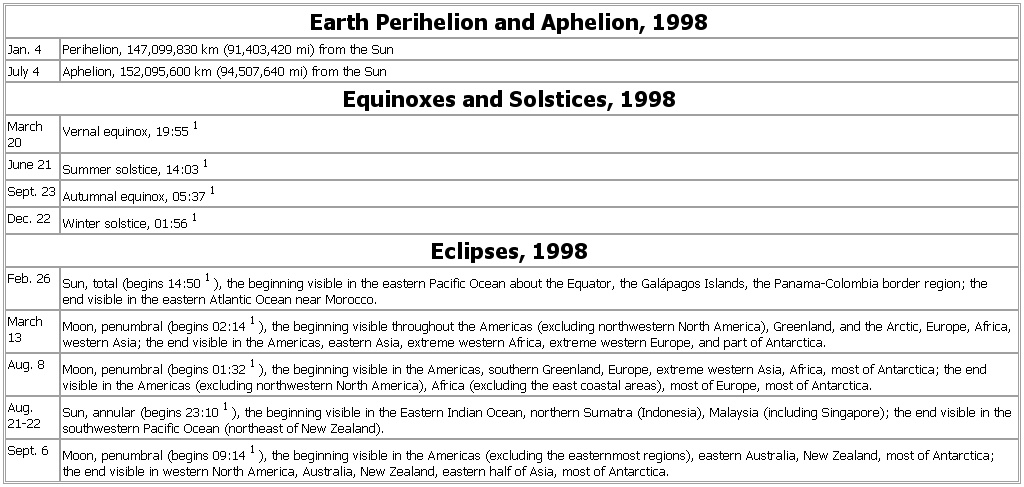- Earth Perihelion and Aphelion, 1998
-
▪ TableEarth Perihelion and Aphelion, 1998Jan. 4 Perihelion, 147,099,830 km (91,403,420 mi) from the SunJuly 4 Aphelion, 152,095,600 km (94,507,640 mi) from the SunEquinoxes and Solstices, 1998March 20 Vernal equinox, 19:551June 21 Summer solstice, 14:031Sept. 23 Autumnal equinox, 05:371Dec. 22 Winter solstice, 01:561Eclipses, 1998Feb. 26 Sun, total (begins 14:501), the beginning visible in the eastern Pacific Ocean about the Equator, the Galápagos Islands, the Panama-Colombia border region; the end visible in the eastern Atlantic Ocean near Morocco.March 13 Moon, penumbral (begins 02:141), the beginning visible throughout the Americas (excluding northwestern North America), Greenland, and the Arctic, Europe, Africa, western Asia; the end visible in the Americas, eastern Asia, extreme western Africa, extreme western Europe, and part of Antarctica.Aug. 8 Moon, penumbral (begins 01:321), the beginning visible in the Americas, southern Greenland, Europe, extreme western Asia, Africa, most of Antarctica; the end visible in the Americas (excluding northwestern North America), Africa (excluding the east coastal areas), most of Europe, most of Antarctica.Aug. 21-22 Sun, annular (begins 23:101), the beginning visible in the Eastern Indian Ocean, northern Sumatra (Indonesia), Malaysia (including Singapore); the end visible in the southwestern Pacific Ocean (northeast of New Zealand).Sept. 6 Moon, penumbral (begins 09:141), the beginning visible in the Americas (excluding the easternmost regions), eastern Australia, New Zealand, most of Antarctica; the end visible in western North America, Australia, New Zealand, eastern half of Asia, most of Antarctica.See as table:
 1Universal time.Source: The Astronomical Almanac for the Year 1998 (1997).
1Universal time.Source: The Astronomical Almanac for the Year 1998 (1997).* * *
Universalium. 2010.
